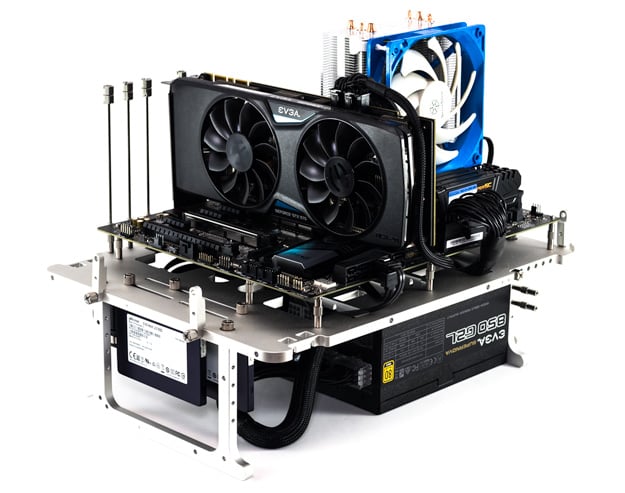Our Test Methodologies
Under each test condition, the Solid State Drives tested here were installed as secondary volumes in our testbed, with a separate drive used for the OS and benchmark installations. Out testbed's motherboard was updated with the latest BIOS available as of press time and AHCI (or RAID) mode was enabled. The SSDs were secure erased prior to testing, and left blank without partitions for some tests, while others required them to be partitioned and formatted, as is the case with our ATTO, PCMark 7, and CrystalDiskMark benchmark tests. Windows firewall, automatic updates and screen savers were all disabled before testing. In all test runs, we rebooted the system, ensured all temp and prefetch data was purged, and waited several minutes for drive activity to settle and for the system to reach an idle state before invoking a test.
 |
| HotHardware Test System |
| Intel Core i7 and SSD Powered |
|
|
Processor -
Motherboard -
Video Card -
Memory -
Audio -
Storage -
|
Hardware Used:
Intel Core i7-6700K
MSI Z170A GAMING M6
(Z170 Chipset, AHCI Enabled)
Intel HD 530
16GB EVGA DDR4-2800
Audio Boost 3
Micron 1100 SATA M.2 512 GB (OS Drive)
Samsung SSD 750 EVO (500GB)
Samsung SSD 850 EVO (500GB)
Intel SSD 730 (480GB)
Crucial M550 (512GB)
OCZ Trion 100 (960GB)
OCZ Trion 150 (480GB)
Micron 5100 MAX (960GB)
Micron 5100 ECO (1920GB)
|
OS -
Chipset Drivers -
DirectX -
Video Drivers -
|
Relevant Software:
Windows 10 x64
Intel 10.1.1.14,
DirectX 12
NVidia GeForce 378.92
Benchmarks Used:
HD Tune v5.50
ATTO v2.47
AS SSD
CrystalDiskMark v3.0.3 x64
PCMark 7
PCMark 8
SiSoftware Sandra 2015 SP3
|

 |
| SiSoft SANDRA 2015 SP3 |
| Synthetic Disk Benchmarking |
|
First up was SiSoft SANDRA, which stands for System ANalyzer, Diagnostic and Reporting Assistant. Here, we used the Physical Disk test suite and provide the results from our comparison SSDs. The benchmarks were run on unformatted drives and read and write performance metrics are detailed below.
Most drives are very capable of saturating SATA’s read speed limits, so write speeds are generally more important to compare in this test. In that regard, both Micron 5100 Series SSDs come out on top with the slightest edge given to the 5100 MAX. Interestingly, both drives do lag slightly in read speeds, though this is unlikely to make any perceivable difference in real-world situations.
 |
| ATTO Disk Benchmark |
| More Information Here: http://bit.ly/btuV6w |
|
ATTO is another "quick and dirty" type of disk benchmark that measures transfer speeds across a specific volume length. It measures raw transfer rates for both reads and writes and graphs them out in an easily interpreted chart. We chose .5KB through 64MB transfer sizes and a queue depth of 6 over a total max volume length of 256MB. ATTO's workloads are sequential in nature and measure raw bandwidth, rather than I/O response time, access latency, etc.
Performance tends to level off around 1MB, so we only display results to 8MB. The Micron 5100 Series drives show poorer than expected results at small transfer sizes, but quickly jump to outpace most of the competition by 4KB in the write tests and by 32KB in read tests. Also interesting is the 5100 ECO’s better read performance between 8K and 64K compared to the 5100 MAX, which could be attributable to the 5100 ECO’s higher capacity and read-focused optimizations.











